Annual Oration 1903
By Herbert L. Burrell, M.D.
Mr. President and Fellows of The Massachusetts Medical Society: The treatment of tuberculosis is a subject that concerns every one. All citizens, particularly members of the medical profession, should recognize that tuberculosis is the greatest scourge of mankind, and is an enemy that all should strive to conquer. We are apt, in these days of individualism, of unbounded opportunity for personal development, of expert knowledge on special subjects, to consider that the great questions of citizenship, such as concern public health, should be left to the care of the state.
Physicians have recognized, in a somewhat limited manner, that tuberculous patients should be under conditions in which they may avoid a reinfection from the tubercle bacillus, and their processes of repair and powers of resistance may be increased to the highest degree.
Surgeons have not been as keen to appreciate these principles in the treatment of tuberculosis as physicians. Their attention has been concentrated on the treatment of the local lesion. Many surgeons consider that a tuberculous area must be removed; some surgeons regard the area as little less than malignant, and feel that a tuberculous lesion must be attacked as if it were a cancer. Relatively few surgeons consider that to increase the patient's power of resistance to fresh invasions of the tubercle bacillus is of as great importance as to operate and remove a local area of tuberculosis.
A few orthopedic surgeons and genito-urinary surgeons recognize the importance of outdoor treatment. General surgeons, however, are too apt to consider that an operation on a local tuberculous area ends their duty. They fail to appreciate that probably in many instances an urea of tuberculosis is simply a local manifestation of a more or less general infection by the tubercle bacillus, in an individual whose power of resistance is lowered.
When the attention of a general surgeon is called to the importance of increasing the powers of resistance in an individual patient, as a rule, he acquiesces to the plan that out-of-door treatment should be given patients with surgical tuberculosis, and in an individual case he may adopt this line of treatment. He does not insist, however, on this treatment being given all patients having surgical tuberculosis.
I, therefore, beg your consideration of the means by which tuberculosis can be treated and what modifications in our methods are desirable. The consideration of the subject divides itself as follows: (1) Prevalence; (2) diminution; (3) pathological consideration; (4) sanatoriums; (5) construction of sanatoriums; (6) hospitals; (7) outdoor treatment of tuberculosis; (8) tent treatment; (9) home treatment; (10) effects of sunlight and electric light; (11) defects of hospital construction.
Prevalence
Tuberculosis in its various manifestations undoubtedly kills more people than any other disease. From one tenth to one seventh of the total death-rate of the world is dependent upon tuberculosis. Craig states that "it has been recently estimated that there are one million cases of active tuberculosis in the United States, and the latest authentic statistics show that 14% of the deaths recorded for ten years are due to some form of tuberculosis."
Cuzner states that "Schlenker made 100 consecutive postmortems on adults and children. He carefully examined every part of their bodies, and in 65% found tuberculosis. In over 4,000 successive postmortems made in Breslau, in 1893, one third of the bodies contained gross tuberculous lesions. If the microscope had been used, probably enough lesions could have been discovered to make 2,500 infections. Babes found lesions of the bronchial glands in more than one half of his postmortems on children. Biggs could demonstrate characteristic lesions in the lungs alone in 60% of his postmortems. Grawitz found primary tuberculous deposits in the lungs in 152 out of 221 cases, this being nearly 70% of all infections.
The most remarkable statistics as to the existence of tuberculosis are those of Naegeli, drawn from 508 consecutive autopsies done at the Pathological Institute at Zurich. Naegeli did 500 consecutive autopsies, and found that 97% of all adults over eighteen years of age who died in the Cantonian Hospital were tuberculous. He states that every organ must be carefully examined, grossly and microscopically, for tuberculosis. When this was done, it was found that 97% of adults, in a series of 104 cases, had tuberculosis. The first two series of autopsies are appended in Table I.

Naegeli found that the constitution of the individual had no influence as to the presence of tuberculosis. The most powerful gymnast, in the prime of his twenty years, was no more immune than the feeble, slender shop-girl with flat thorax and so-called phthisical habit. He found that latent tuberculosis was to be found not alone in those who suffered from chronic affections, but in those who died suddenly from wounds of all kinds.
The next two series of autopsies, 346, were even more carefully performed, and showed from 97% to 98% of tuberculosis in adults.

He found that in the first year tuberculosis is exceedingly rare; from one to five years it is still rare but is nearly always fatal; from five to fourteen years it is found in one third of all bodies examined and causes the death of three fourths of those it attacks. Reasoning from these statistics, between fourteen and eighteen years, one half of the population bus been infected with tuberculosis, and the process is then always active and but rarely arrested. One third of all deaths that occur at this period of life are due to tuberculosis.
Diminution
That there has been a great diminution in the number of cases of tuberculosis is readily shown by statistics. Dr. Samuel W. Abbott, secretary of the State Board or Health of Massachusetts, states that in New England, with a population of 5,103,187, for the five years 1893-1897 there were 50,027 deaths, a rate of 19.70 per 10,000. The decrease in the last half century is remarkable. In 1853 the death-rate from pulmonary tuberculosis in Massachusetts was 42 per 10,000 inhabitants; in 1895 the death-rate was 21.8 per 10,000 inhabitants.
The following table, taken from Nothnagel, showing the mortality from tuberculosis and phthisis in Continental countries from 1876 to 1897, shows the diminishing prevalence.

It is naturally interesting to consider the causes that have diminished the frequency of tuberculosis. Dr. Alfred Hiller, in a paper on the "Extinction of Tuberculosis," gives a striking chart showing that at the present rate of decrease in the deaths from pulmonary tuberculosis, Prussia will reach the zero point about the year 1927, whereas in England at that time there will be about eight deaths per 10,000, and the total extinction will take place only about twenty years later. The rapid fall in the Prussian rate is ascribed to (1) the precautions against infectious diseases, due to the discovery of the tubercle bacillus; (2) the improved conditions of the working classes caused by the Workmen's State Insurance Laws; (3) the establishment of sanatoriums.
Table IV gives the mortality of 662 villages in France from phthisis and other forms of tuberculosis in 1891. This presents a general idea of the relative frequency of phthisis to other tuberculous affections, and it demonstrates the large number of cases of tuberculosis that occur in a large city like Paris, when compared with a village of 5,000 inhabitants. The number of cases to the thousand inhabitants in Paris that occurred was 4.9%. The number of cases to the thousand inhabitants in places less than 5,000 inhabitants was 1.81%.

The greater danger of urban life is exemplified by this statement of Dr. H. M. Biggs of the New York Health Board, that "one block on Cherry Street was inspected on Jan. 1, 1895, and contained 1,000 tenants. One hundred and four cases of tuberculosis have been reported in that block in four years nine months. In a block on Pell and Mott streets, containing a population of 2,000, 318 cases occurred in four and a half years.
The relative frequency of surgical tuberculosis is difficult to determine, because the mortality statistics do not, as a rule, record surgical tuberculosis. Table V gives one an impression as to the relative frequency of tuberculous affections other than phthisis. The tables show the mortality at Hamburg in 1872-1898.
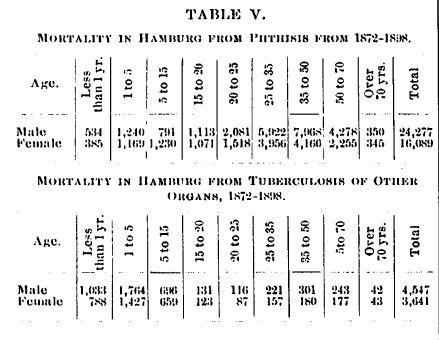
Leonte states that surgical tuberculosis is most prevalent from ten to thirty years of age.
His conclusions are drawn from the following series of cases: From 1896 to 1899 there were 1,393 cases treated in the hospitals of Roumania; from 1895 to 1899, 2,949 cases were treated in the hospitals of Ephorie; from 1898 to 1900 there were 149 cases treated in Leonte's hospital service at Brâncoveassu. A large number of these cases of surgical tuberculosis were of the bones and joints.
Summary.— From the above statistics I think it is fair to state that from 80% to 90% of men and women who reach the age of forty years have had some form of tuberculosis. This statement, if true, is significant and illuminating. It should give us the point of view that in dealing with tuberculosis we have a universal enemy, but that, after all, the majority of us are going to conquer this enemy. Tuberculosis is often spoken of as malignant in character, yet this can hardly be true, for if it were malignant in the majority of individuals the human race would be swept from the face of the earth.
Pathological Considerations.
The knowledge of the behavior of the tissues when infected with tubercle bacilli will be of assistance in defining the treatment that should be given an individual case.
The following brief account of the pathology of the disease is abstracted from the syllabus of pathology by Drs. Councilman and Mallory: The organism enters through the respiratory tract or alimentary canal. It may enter also through the skin, through wounds, in which case a local lesion is produced. The extent and character of the lesion depends upon the number of bacilli, their virulence, the susceptibility of the individual, and upon the mode of infection and the anatomical character of the organ infected. The usual effect produced by tubercle bacilli is proliferation of cells, leading to the production of large epithelioid cells. The tubercle bacilli lie in and between the cells. Later
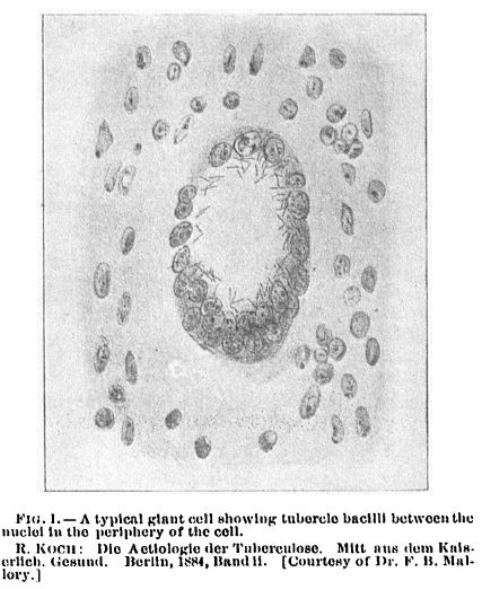
other cells appear, the most conspicuous of which are the giant cells. Miliary tubercles are formed of epithelioid and giant cells with or without a reticulum and are small circumscribed masses varying from .1 mm. to 1 mm. in size. Miliary tubercles undergo degenerative changes, but they do not tend to increase in size by peripheral growth. A nodule is formed by the continuous formation of miliary tubercles in the periphery. With the cell proliferation, which is dependent upon the presence of tubercle bacilli, there is more or less exudation, and this forms a part of the tuberculous area. A miliary tubercle docs not tend to enlarge indefinitely, chiefly because there is gradually formed around it a tissue which is relatively resistant to the action of the bacilli. Such a tissue is also formed around the large conglomerate tubercles. This tissue is converted into dense, cicatricial tissue resistant to the action of bacilli and containing few blood vessels or spaces by means of which the bacilli can pass through the encircling wall. This is peculiarly interesting, for it may plainly be seen that a great effort is made by nature to encompass and control the attack of the bacillus. It is not known how long tubercle bacilli can live enclosed in such a mass. Occasionally the barrier may be penetrated and the old focus form the starting point of a fresh infection. The most rapidly fatal forms of tuberculosis are those in which the exudative processes are the chief lesions. The mass
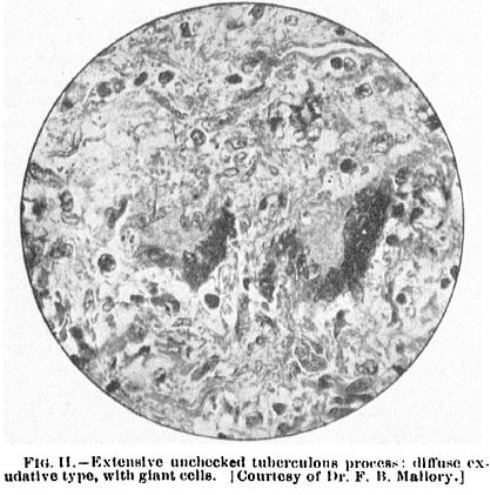
formed by the cascation of tuberculous tissue and exudation may remain in an unchanged condition. If composed chiefly of cells it is soft and easily broken up. It is firmer if connective tissue has entered into its formation. It finally may become calcified. A much more important process is that
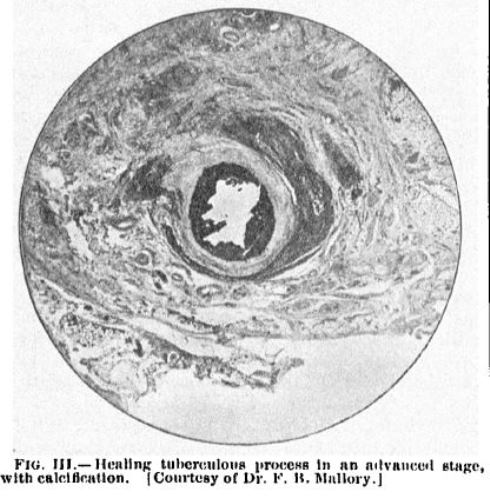
of softening. By this the comparatively firm caseous mass becomes changed into a soft or semi-fluid material. This softened material may be carried into the surrounding tissues, and general infection may occur. Accepting that this is the general behavior of a tuberculous infection, whether it be in the lung or in the intestine, it is apparent that nature is doing all she can to combat the infection, and that we should simply supplement nature in her efforts. A tuberculous process in a lung and in a joint differ largely because of the anatomical differences in the tissues invaded, but the same general principles of infection and repair maintain.
How can we assist nature in her effort to cure the ravages of the tubercle bacillus? She herself surrounds the infection as soon as may be by a wall of dense fibrous tissue. It seems to me that physiological rest, to the involved structure, and improving the powers of resistance of the individual, are clearly the lines along which we should render assistance. This leads naturally to the treatment of tuberculosis in sanatoriums, out of doors and in hospitals.
Sanatoriums.
The great value of sanatoriums is not alone the control of the infectious patient, but their educational influence on the tuberculous patient. Patients are taught a proper conduct of life, taught to protect their fellow-beings from infection, and they are placed, in many instances, on the road to permanent recovery.
The principles of sanatorium treatment in general are well laid down by Dr. T. N. Kelynack. He states that in selecting a suitable case for sanatorium treatment it is well to remember what hygienic management seeks to secure: (1) The removal of the patient from fresh invasion by the tubercle bacillus, and separation, as far as possible, from all influences aiding in its introduction. (2) The establishment in the patient of processes of repair and the development of the highest power of resistance. To this end the instruments employed are: (1) Continuous exposure to fresh air. (2) Free access to sunlight. (3) Regulated rest. (4) Controlled exercise. (5) Abundant feeding. (6) Obedience to hygienic requirements. (7) Strict medical supervision. The life in a sanatorium is well described in an article by John H. Lowman ("The Conflict with Tuberculosis," Cleveland Medical Journal, October and November, 1902). He slates that the food in a private hospital is such as one would find in a good, well-managed hotel. The patients are allowed to eat as much as they please, but are not forced. As the patient gets stronger he is allowed more exercise. Patients, as a rule, sleep well. The windows are widely opened at night, except in the coldest weather, when the transom is opened. The life in a sanatorium is monotonous, but not necessarily irksome. Amusements are discouraged; cards and casino life are not permitted. Even chapel exercises and churchgoing tire not approved. A visit to the neighboring village is apt to be followed by a cold, which is in reality an infection caught from association with outside people.
In England, sanatoriums have existed for many years and they are regarded as places for the cure of tuberculosis, not as the home of incurable cases. In France, there are a few sanatoriums, principally devoted to the care of children. Germany one finds to be the home of the sanatorium.
The greatest credit is due to such men as Brehmer, who first started the sanatorium at Goerbersdorf in 1856. In this country we owe a debt of gratitude to Trudeau, of Saranac Lake, who has demonstrated in such a public-spirited manner the value of sanatoriums.
The Imperial Health Office at Berlin states there are at present fifty-seven public sanatoriums for the tuberculous in Germany, of which thirty-four are located in Prussia. The Imperial German Government, the governments of the different states, the executive authorities, the national insurance institutions and the municipal governments are seriously and actively participating in the work of combating tuberculosis.
Germany is the best equipped country in the world for the treatment of tuberculosis, and its statistics show correspondingly favorable results. Hammer states that in Germany 20,000 people can be given yearly a three-months' treatment in her institutions.
The relation of the insurance companies in Germany to the control of tuberculosis is very interesting, and it is hoped that action may be taken by some of the insurance companies in this country towards controlling tuberculosis. The Old Age and Invalid pension laws of Germany (Lowman, ibid.), which were formulated by Bismarck are very suggestive in their scope of action. Under this law every workman and domestic must be insured by his employer against incapacity for work from old age or invalid ism and against sickness and accident. Under this law are a number of sick benefit insurance societies, and their reserved fund is $170,000,000. From this fund the sanatoriums are sustained. By an amendment to this law, passed by the Reichstag and called Paragraph 45, the insurance societies are permitted to withhold the weekly money benefit from a beneficiary and give it to a sanatorium, and compel the patient to go there to reap the advantage of his insurance.
Frank Warner states that the United States as a government operates but two sanatoriums, one the Army Hospital and Sanatorium for the treatment of pulmonary tuberculosis at Fort Bayard, New Mexico, and the other the United States Marine Hospital Service Sanatorium at Fort Stanton, New Mexico. One has only to read the reports of these sanatoriums to become convinced that the amount of good accomplished is very great. The New Jersey Legislature has appropriated $300,000 for a sanatorium in which the tuberculous poor may be treated.
Massachusetts has established a State sanatorium at Rutland, but Boston has been singularly negligent in this important, public duty. Freudenthal states that there are 25,000 tuberculous patients in the Borough of Manhattan and recommends the establishing of "farming colonies." He states: "We can acquire hind enough in this State and in many places near by at a very reasonable price for the purpose of establishing farming colonies. This should be laid out in large farms, and these will fulfill several requirements. Part of the ground should be used for the erection of dwellings for the consumptive colonists and the rest cultivated. While a large, handsome hospital building with all modern improvements looks imposing, it in entirely too expensive for the purpose. I therefore propose to erect tents instead. You can erect many tents for the amount of money that would have to be expended on one building alone. That all hygienic demands can be fulfilled in the best and cheapest way in tent life, every one who has had some experience on that subject will admit." Directly in line of this statement is the statement that there is proposed a sanatorium for the treatment of tuberculosis in New York City with an estimated cost of buildings of $530,000, 480 beds. This plan provides for a group of structures, the general arrangement of which will be fan-shaped, with the administrative building in the center and the pavilions projecting like the sticks of a fan, thus giving each pavilion a maximum of light and air. The pavilions are to be two stories in height and connect with each other and the administrative building by covered corridors. Here are two definite plans, one for a sanatorium outside a great city, the other for treatment in tents. The proposed sanatorium to cost $530,000 with 480 beds is too expensive to meet the problem that is presented in the control of tuberculosis.
There is a definite drift of opinion that a change of climate is of less importance in the treatment of tuberculous patients than was supposed, and that it is far more important that the tuberculous should have open air life and a maximum of sunshine, wherever they may live. Kime very sensibly states that in treating tuberculosis "it is not a question of climate, of elevation, of heat and cold, of dryness or of moisture. Wherever an abundance of God's pure air and sunshine, may be had, there may this disease be successfully treated."
I give some illustrations showing one of the barracks (Fig. IV) and one of the resting-places (Fig. V) at the sanatorium at Magdeburg. Figs. VI and VII are views of Trudeau's sanatorium at Saranac. Figs. IV, V, VI and VII are taken from Zeitschrift für Tuberkulose und Heilstattenusen, Band 1, 1900.
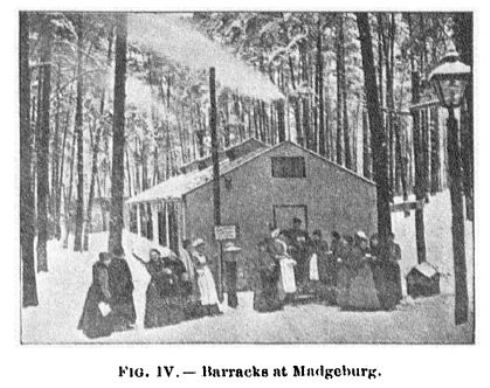
In France there are over 20 seaside and mountain sanatoriums, with between 2,000 and 3,000 beds, mostly for children with tuberculosis. At Ormessau and Villiers the sanatoriums are on a breezy and somewhat unprotected high plateau. The treatment of tuberculous children at the sanatorium at Cap-Breton and at Berck-sur-mer is of a good deal of interest.
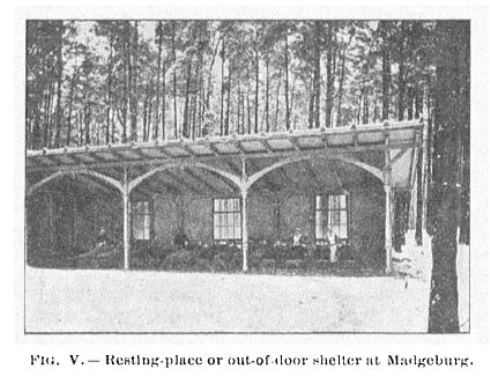
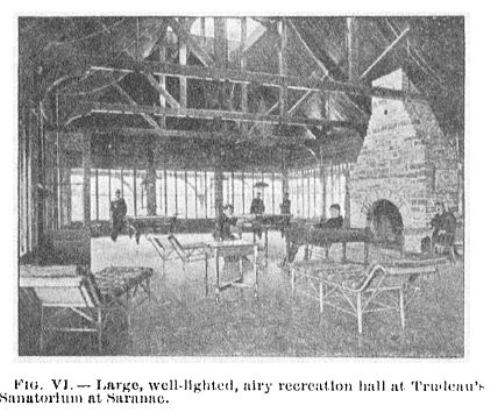
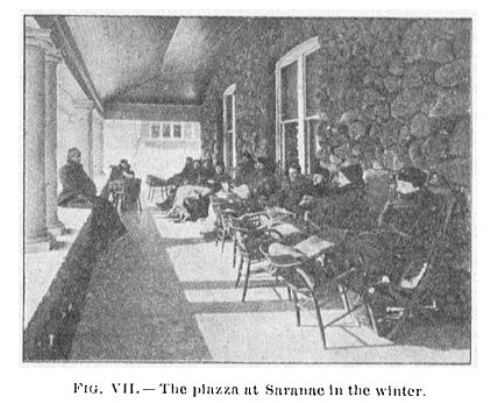
Lalanne has charge of the sanatorium at Cap-Breton for the treatment of scrofulous lesions. Cap-Breton is not really a village, but a multitude of little Swiss cottages scattered over the sand near pine forests and close to the ocean. The sanatorium of Cap-Breton is situated upon a dune twenty meters above sea level and one hundred meters from the shore. This sanatorium was founded by Widow Desjobert, who left 1,200,000 francs to establish a hospital for poor scrofulous children. In this sanatorium there is an abundance of air and light. The climate of Cap-Breton is influenced by the following factors: (1) The nearness of the ocean, (2) the passage of the Gulf Stream some kilometers from the shore, (3) the proximity of the pine forests. The mean temperatures at Cap-Breton are 13° C. in the spring, 22° C. in the summer, 14° C. in the autumn and 9° C. in the winter. In the coldest weather the temperature at Cap-Breton has never fallen below 1° C. Here also there is an abundance of sunlight. The pine forests tire far enough away so that they do not affect the action of the sun's rays. There are about 250 sunny days in the year. The water is warm enough for bathing from July 1 to October. At other seasons house baths of warmed sea water are used. The windows of the sanatorium tire kept open during the winter nights, to permit plenty of fresh air. During the winter days the patients can be out the entire day upon the beach, warming themselves in the sun. Seventy-one per cent of patients received at Cap-Breton are cured. Lalanne gives the following typical picture of the improvement of a child: Upon his arrival at the seashore the child is pale, indolent, sad and morose. He is weak and owing to the bad air of the large cities and the lack of hygienic surroundings. He dislikes to move, and nothing interests him. The appetite (though sometimes good) is often poor, capricious and irregular. A few days after his arrival his appetite improves, but the greatest improvement is to be seen only after some weeks or even months. Then there is a veritable transformation: his condition is stronger, he has the color of health, his muscular powers are doubled, he no longer has that torpor and indolence, he is full of that animation which characterizes children with strong constitutions, he is gay, active, expansive and turbulent. Surgical treatment at Cap-Breton is eminently conservative. They seek to improve the debilitated constitutions, and only intervene surgically when it is absolutely necessary. Prolonged treatment at the seashore often suffices to cure many tuberculous manifestations without surgical intervention.
At the sanatorium at Berck-sur-mer, Calot treats many forms of external tuberculosis. The general treatment of these cases consists of the use of some medicines, cod liver oil, etc., wholesome, abundant food, the observance of good hygiene, the choice of a proper climate and a proper place. Calot believes that sea air is preferable to the air of the country. This probably is a detail. Calot has children even in bed who are taken out daily during the whole winter; the hood of their little carriages protects them from the rain and snow, and large coverings protect them from the cold. The face is uncovered or is half protected with a veil. The cold weather stimulates the appetite and all the tissues of the organism. The temperature rarely becomes so severe as to prevent patients going out. One of the hospitals at Berck was temporarily located 500 meters from the sea for one year and then was moved to the shore. Calot and his assistants noticed that after exposure of the sick to the sea air, the cures of the worst cases became more numerous, more rapid and more complete.
Lannelongue, Gibney and Sprengel all recognize the importance of general and outdoor treatment of tuberculous children.
Formiliant reports excellent results obtained in the sanatorium on the shores of the Baltic Sea near Windau. Marcou-Mutzner refers to a sanatorium at Hendaye of 200 beds, where they receive children from two to fifteen years of age. The sojourn is from six to nine months. The classes of cases include rickets and anemia, but especially cases of initial visceral tuberculosis. The therapeutic agents are the sea air and climate, not extra alimentation and not rest. In one sanatorium it costs but ninety centimes per day to support a patient.
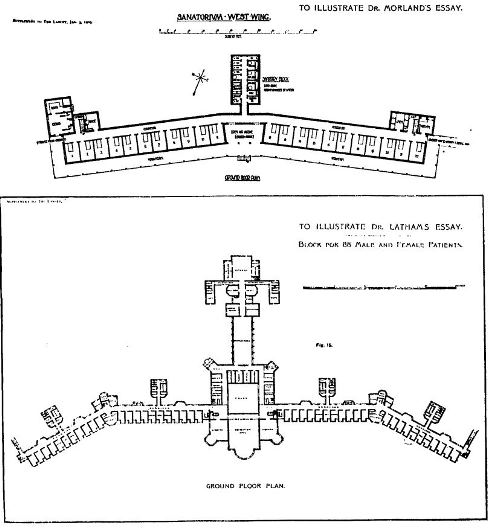
Construction Of Sanatoriums.
It is interesting to see the different supplementary plans that are advocated for the treatment of tuberculosis. Let me mention that of Dr. Lederle of the New York Health Department, who has sent a letter to Mayor Low urging the appropriation of $35,000 for the establishment of a sanatorium for the treatment of tuberculosis on the tent plan. It is proposed to erect this camp on a tract of twenty acres in Orange County, which has been offered to the city for two years, rent free. Dr. Lederle states that with the $35,000 he could provide a camp for sixty patients from May 1 to Dec. 31 next. In Germany the following plan has been advocated: Several physicians and a number of associations in Berlin propose to build a large floating sanatorium with roomy, open-air wards, medical supervision, and a complete equipment for scientifically testing the effects of sea air on tuberculosis. The cruising ground is to be the northeastern Atlantic, in the neighborhood of the Canary Islands. Should success attend the effort, other floating sanatoriums will be built. The voyages will last about six weeks.
A most valuable competition occurred recently in England, where King Edward VII offered prizes for the best essay with plans for a sanatorium for tuberculosis in England. One hundred and eighty essays were submitted in competion, and the three prize essays were published in the Lancet of Jan. 3, 1903.
The plans of Dr. Latham's essay, Fig. VIII, and Dr. Morland's essay, Fig. IX, appeal to me, in that they offer a maximum of sunshine and fresh air.
Hospitals.
Hospitals have not, as a rule, recognized the necessity for providing for the out-door treatment of tuberculosis. Dr. F. Rufenaehl states that "in several of the general hospitals and infirmaries in England, such as St. Thomas' Hospital in London, the North Staffordshire Infirmary at Stoke upon Trent, the Sheffield Royal Infirmary, etc., consumptive patients have been treated with more or less success by open-air methods. In the new infirmary for Camberwell the top story in each wing is to be set apart for the open-air treatment of consumptives, and is to have nearly all its wall space occupied by windows."
Burdett states that "the Bethany Hospital in Berlin has had broad balconies added to the wards, where many of the patients are kept in bed, not only in the daytime, but at night." He gives plans and descriptions of the new University Hospital at Halle, which has wide verandas on the south side of the four surgical wards only, the windows being easements, opening down to the floor, so that a bed can be rolled or carried out. He states that the new hospital at Saint-Denis also has verandas on the south side of the wards. The story of the doctors who kept their patients out on the balcony until nine o'clock at night, and finally tried leaving them out all night, at the Bethanien Hospital in Berlin, is interesting. They were entirely convinced by practical experience, by patients sleeping out of doors, of the benefit of this treatment.
Out-door Treatment of Tuberculosis.
All of the foregoing leads me to believe that the necessity for out-door treatment of surgical tuberculosis is not sufficiently well recognized by general surgeons.
The improvement that occurs in tuberculous nodes of the neck, without operation, has for years attracted my attention, and in many instances where an operation was inexpedient I have advised the patient to live and sleep out of doors. In the majority of these cases there has been marked improvement, and in some cases apparently permanent recovery.
One of the first instances that attracted my attention to the importance of the out-door treatment of surgical tuberculosis was a patient upon whom I had operated for tuberculous peritonitis. The patient, a woman, aged thirty-eight, had a typical condition of the peritoneal cavity. She was operated upon, a large amount of fluid was removed, the peritoneal cavity was drained for a fortnight, and the abdominal wound then healed; yet for months the patient did not improve in the way we expect, an operation for tuberculosis of the peritoneum. During the summer she lived in a tent, and from the time that she lived and slept out of doors her improvement was very marked. During the summer she gained eighteen pounds, till evidence of tuberculosis disappeared, and three years later she was apparently in perfect health. At the time this occurred I considered that her improvement was simply a delayed one following operation.
A most striking instance of improvement occurred three years ago. A man, thirty-seven years of age, who was married, came to me for tuberculous epididymitis. The vas deferens on the affected side was corded and knotty. A careful examination of the urine was made, and tubercle bacilli were eventually found. Naturally an unfavorable prognosis seemed inevitable. An operation was done, and the tuberculous testis and cord were removed. After waiting three or four weeks, the patient having cystitis with tenesmus, a suprapubic cystotomy was done. Two small tuberculous areas, one the size of the little finger-nail, were found at the base of the bladder. Suprapubic drainage was established, and I finally advised the patient to go to his home and make himself as comfortable as possible, as a fatal ending was more than probable. The patient was of more than ordinary intelligence, and, turning to me, asked if there were nothing else that could be done in the way of general treatment for the disease. He himself suggested to me that if people with pulmonary tuberculosis weree benfited by living out of doors, he might be made better by living and sleeping out of doors. I, of course, acquiesced, and he had a tent constructed on his lawn and slept there from April 15 until into December—out of doors practically every night, during the summer. He gained during this time thirty-four pounds, or from 118 pounds to 152 pounds. At the end of three years apparently the tuberculous process has been arrested, lie is engaged in his ordinary occupation, that of a book-keeper, and I believe his life has been saved, not by my operation, but by a recognition of the value of outdoor treatment of tuberculosis.
In spite of the warnings and protests of experts in the treatment of pulmonary tuberculosis, two errors with regard to the out-door treatment of pulmonary tuberculosis remain deep-rooted and widespread in the profession. The first is the sending of patients in advanced stages of tuberculosis to sanatoriums. The second is the failure to recognize the need of absolute rest, literally sitting still out of doors all day long, on every day, so long as there is evidence that the tuberculous process is still active.
Trudeau has intelligently insisted upon the need of absolute rest during the active period of tuberculosis.
The natural cure of tuberculous areas, it seems to me, demands three things: (1) Physiological rest to the part; (2) pure air and sunlight; (3) ample nutrition to the tissues to check the progress of the process. At the best, the tuberculous area in a lung must "throw out of commission" that part of the lung for the time being. There are not many principles in medicine or surgery, but if there is one in which I thoroughly believe, it is that of physiological rest, and this principle is just as applicable to the treatment of pulmonary tuberculosis as it is to the treatment of a tuberculous area in the hip- or knee-joint.
Tent Treatment.
Occasionally, here and there, within the past few years have appeared suggestions as to the out-door treatment of surgical tuberculosis. Dr. H. P. H. Galloway in 1902, before the American Orthopedic Association, brought forward and advocated strongly the use of tents for the treatment of tuberculous joint-disease (Fig. X). Dr. Galloway claims that while out-door life is of great assistance in the treatment of all tuberculous bone and joint affections, it is particularly useful in that class of patients whose recuperative power seems to have been exhausted and are being slowly worn out by discharging sinuses which other means of treatment have failed to heal. He does not claim that tents offer the best solution of the problem of securing the nearest approach to continuous out-door life, but that properly designed tents suitably located are much better than the average hospital ward, and that they are an efficient and inexpensive supplement to the regular wards. He thinks that, with private patients an effort should be made to secure the benefit of sunshine and fresh air, when for any reason residence in a sanatorium is impracticable or undesirable. Many patients who have a lawn in connection with their homes can be induced to fit up a private tent and occupy it even during the winter months.
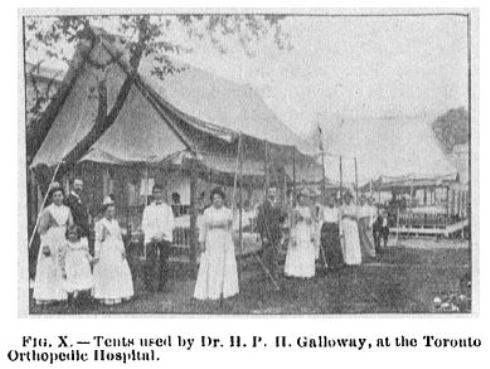

For many years the Boston City Hospital, under the administration of Dr. Rowe, has had a tent service in summer, in which, at times, surgical patients have been treated. The advantages of this service have been very marked. Figs. XI and XII show the perspective of this outdoor camp and an interior view of one of the tent wards.
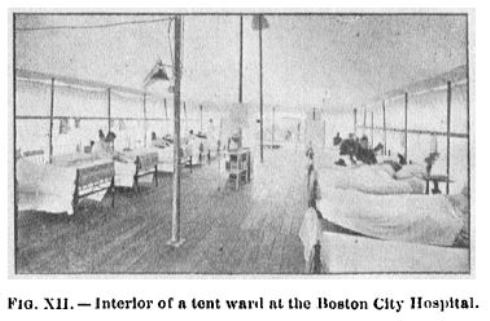
The means to gain this outdoor life for patients are many. An excellent type of tent is described by A. Mansfield Holmes. Figs. XIII, XIV and XV show the construction of the tent pavilion.

The approximate cost of constructing these tent cottages is $60.

Home Treatment.
Dr. Millet, of East Bridgewater, has recognized the necessity for caring for his patients by out-door life, and his article on ''The Night-Air of New England in the Treatment of Consumption" is extremely suggestive and very valuable. Dr. Millet has been good enough to let me have illustrations of the "shacks" that he has had built for the treatment of tuberculous patients (Figs. XVI and XVII), also of the balconies or verandas where patients sleep, that have been "built out" in connection with many cottages. Figs. XVIII, XIX, XX, XXI and XXII are balconies built out from buildings in Brockton and Bridgewater, and here the patients sleep, from May until November or December, only the rainy nights driving them in. The improvement in these cases, I am told by Dr. Millet, is very great indeed.

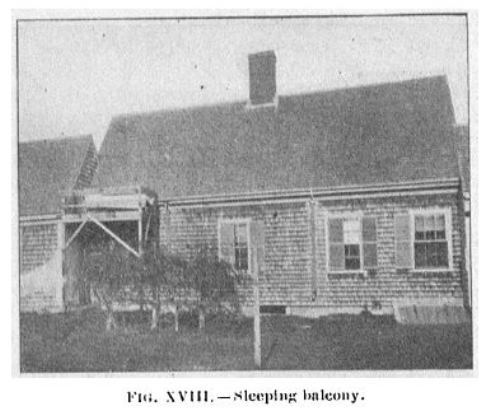
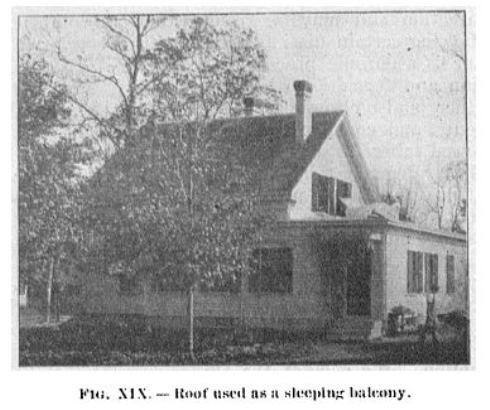
 The public are quite aware of the benefits of out-of-door treatment, and Phil May has expressed in Punch, March 4, 1903, the length to which this fad may be carried (Fig. XXIII).
The public are quite aware of the benefits of out-of-door treatment, and Phil May has expressed in Punch, March 4, 1903, the length to which this fad may be carried (Fig. XXIII).
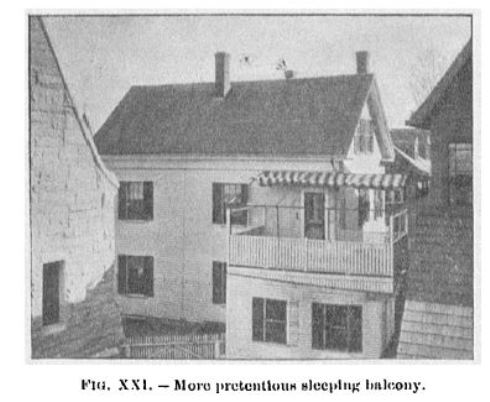
A. A. Babrow believes that surgical or local tuberculosis is simply a manifestation of a general infection and may be grouped under two forms, showing certain dissimilarities in their course; the one is a chronic process characterized by infiltration and formation of new connective tissue; the other is also chronic at times, though oftener subacute, and consists in a cellular infiltration which forms tubercles and through their necrosis leads to cheesy degeneration. In either instance the advent of pus cocci transforms the sluggish process into an acute inflammation. In the absence of a specific remedy our therapeutic efforts must aim at increasing the patient's resisting powers, thus aiding him to overcome the microbic invaders. All hope of salvation by removing the diseased part is distinctly illusory, since surgical tuberculosis must be considered as the local manifestation of a general infection. We combat the chronic non-suppurating variety with local rest and counter-irritating measures, like hot applications, iodin or the cautery, which all act beneficially by attracting leucocytes and phagocytes to the affected tissues, as well as by stimulating the local circulation. A similar result is obtained by incising and packing with gauze strips, in order to direct the current of tissue, fluids outward. These measures, however, are inadequate when we conic to deal with necrotic and suppurating forms of local tuberculosis. Here active interference is called for, and operative removal of dead or diseased tissue is advisable. It is to be recognized that such operations are merely palliative measures, as the complete removal of affected areas is impossible in, view of the persistent general source of infection. When this truth is recognized, surgeons will no longer be so anxious to operate, but, will seek rather to increase the strength of the patient and pave the way for nature's own cure. In this connection climatic influences deserve all recognition. Prolonged stay (one to one and one-half years) at the seashore exerts a marked salutory effect, especially in the case of children; the sea air, the bathing and, not least, the sunlight, contribute their respective share to the final result. Solar rays play a highly important rôle in the treatment of local tuberculosis, and patients should be instructed to expose the diseased parts to the sunlight.
Effects of Sunlight and Electric Light.
ln connection with the exposure of wounds to sunlight, it is interesting to consider the use of the Finsen light. Dr. Valdemar Bie, who is associated with Finsen at Copenhagen, as his assistant, stales that Finsen has discovered that sunlight or are electric light produces a widening of the skin capillaries which may last for live or six months.
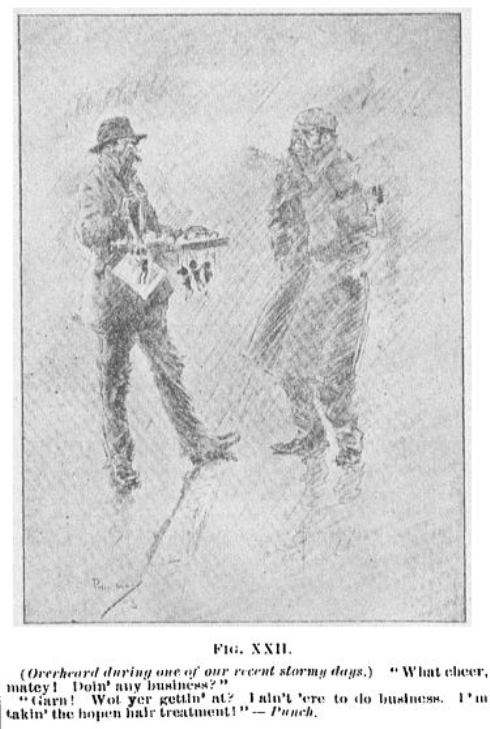
"Finsen has demonstrated a widening of the capillaries of the skin which lasts for a long time, as a result of light. Finsen exposed the skin of his arm to an electric arc light; upon the arm were various glass plates and also two letters of the alphabet drawn with India ink; where these covered the skin, the skin retained its while color; the lighted part of the skin, on the contrary, became red, swollen and later pigmented. After a period of four months the skin was still so pigmented that the while areas were still visible whore the glass plates had been; but after live or six months the entire skin was white. If one now rubbed the skin, the marks again became visible, in that the portions of the skin which had been covered with the glass plates did not become so red as the surrounding skin. The dilatation of the vessels of the skin which results from exposure to light can, therefore, last five to six months."
The effect upon the capillaries is only produced where the ultra-violet rays strike the skin. Light produces a stimulating effect upon all the lower animals, and Finsen has proven this upon the embryos of salamanders and upon worms. He has also shown that the stimulating influence is due to the, actinic rays. These rays penetrate cartilage and skin, but are absorbed by the blood. This was interestingly proven by Finsen, who found that by rendering the ear bloodless the light would pass through the cartilage and would not pass through the ear when it was filled with blood. The ultraviolet rays have ten times as much bactericidal power as all the rest of the spectrum taken together, but they have very little power of passing through the skin. The chemical rays of light do not reach the deeper parts of the body at all, or at most in a very limited degree. The literature on the use of Finsen's rays is becoming very interesting, and one of the best articles is that called "Phototherapy," by Prof. Niels R. Finsen, Copenhagen, translated by James H. Sequeira, M.D., Lond., M.R.C.P., 1901. There can be little doubt but, that the use of Finsen's rays is of definite value, in certain cases. Its exact value and limitations have not been determined, but, the use of sunlight, it is clear, has been demonstrated from time immemorial, Professor Poucet allows the sunlight to fall upon a diseased joint, two or three, hours daily, and Milliez has written a thesis on this subject. Poucet states: "I cannot criticise the results that Milliez describes as good; but a direct influence upon the tubercle bacilli in this way is not possible; it is hardly to be denied that the nourishment of the limb may possibly be improved by the rich blood supply which results from the light bath."
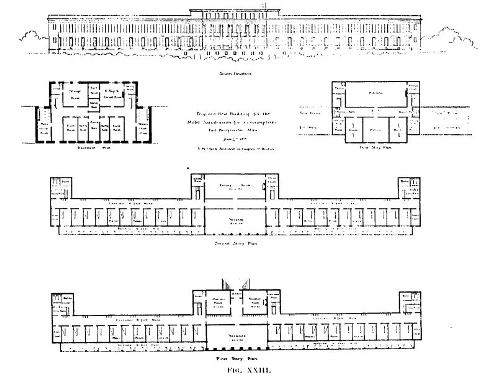
Robinson states that the importance of sunlight in tuberculosis patients is becoming more and more generally recognized. Abrams has done some interesting experimentation on the penetrability of the solar rays. He finds that a dry skin is very resistant to the penetration of the solar rays; that the penetrability of the skin is increased by using lanolin externally and subcutaneous injections of distilled water. A very interesting experiment was done, which should be verified. Subcutaneous inoculations with a virulent culture growth of tubercle bacilli were made upon rabbits. The animals were then subjected to the action of the solar rays concentrated at the point of inoculation on ten consecutive days. No tuberculous process resulted, while in other rabbits similarly inoculated, but not subjected to sun, there resulted tubercles (in which tubercle bacilli were found).
"Other experiments were conducted to determine whether the solar rays in greater concentration could be employed by interposing colored glass, which, in a measure, excluded the heat rays and allowed unimpeded passage to the chemic rays. The result was an unequivocal demonstration of the fact that when such media were interposed it was always at the expense of the actinic action on solio-paper." Abrams has used the solar ray in the treatment of a tuberculous ulcer of leg which had resisted the conventional treatment, including rest and curetting, for over a year. The ulcer healed in less than three weeks under treatment with the solar rays. He has also used solar rays quite extensively in aborting furuncles and in the treatment of cervical lymph noditis of presumable tuberculous origin.
My colleague, Dr. F. S. Watson, has written me a letter, of which the following is an abstract. The letter shows clearly that the out-of-door treatment of surgical tuberculosis is not properly recognized.
Dear Dr. Burrell: It is a remarkable fact that, with the constantly present, object lesson afforded by the results of climatic and hygienic treatment of pulmonary tuberculosis, when properly and conscientiously carried out, as it is in the best, sanatoriums and elsewhere in the hands of some experts Individually, so little effort should have been made to apply the same principles to those forms of disease usually classed as surgical. That this is true is indicated by such facts as the following: —
(1) No paper has been presented before the American Surgical Association urging the adoption of that method of treatment for surgical eases, whether in conjunction with or without, surgical treatment.
(2) Physicians connected with sanatoriums for the treatment of tuberculous disease, and those practicing in the health resorts frequented by persons with phthisis, see but very few patients having surgical forms of the malady. This is illustrated by an inquiry recently undertaken by the writer as to the results of the climatic treatment in that class of cases, in the course of which he addressed a circular letter to every member of the American Climatological Association, which almost all of them were kind enough to answer. The questions were put with regard to tuberculosis of the genito-urinary organs only, and asked the personal experience of those gentlemen as to the results of its climatic treatment. There were just four out of the whole number who did not say that, they had no experience in the care of such cases. Of the four, there was one who had had twelve patients of the sort, and the other three reported their observations with regard to from one to four eases, and had not seen more than that number. Some years ago a similar request for information was sent to representative general practitioners, and twenty none of them had knowledge of more than three cases at the most, and there were but two or three patients whose history was known definitely for long enough periods to give them any value.
The replies of the members of the American Climatological Association furnished the following information with regard to sixteen cases: In live there was complete arrest of the disease. Seven showed great improvement, but still bad evidence of the disease. Two were not improved. Two died.
The reply of Dr. Henry Loomis is of interest, though it does not supply details. He says, "A number of cases have been sent to the Loomis Sanatorium by genito-urinary specialists for climatic treatment. The results have surprised everybody" in their favorable character. He refers specifically to one case considered as hopelessly ill by Dr. Keyes, who sent him for that form of treatment, in which the patient, was "perfectly well at the end of a year."
It is not necessary to quote from the other letters. I will refer briefly to six cases under my own observation for periods of eighteen years in the longest to ten years in the shortest, in which the patients, though not, having been under systematic climatic treatment, have all led outdoor lives and been in very favorable conditions. Three of them were subjects of renal and three of testicular tuberculosis. In all there has apparently been an entire arrest of the process. In one the disease began in the testes and the seminal vesicles were invaded. Here it has remained without further extension for five years, the patient, being in robust health all the while.
This year at the meeting of the American Association of Genito-Urinary Surgeons in Washington, one of the best and most experienced observers among the surgeons of this country, Dr. Chismore of San Francisco, made the first, definite and strong plea that has been presented to the Association for a more extended trial of climatic treatment for eases of genito-urinary tuberculosis, as opposed to the surgical treatment.
We are fairly familiar with the results of surgical treatment of some forms of tuberculosis, notably those in which the disease is sealed in the bones, which is the most favorable form of tuberculosis which comes under the surgeon's care, and those which involve the genito-urinary tract, in some of which the radical surgical treatment is far from encouraging, to say the least, — nephrectomy tor renal tuberculosis, for example, despite the few brilliant successes that have attended it.
What we lack is knowledge of what can he accomplished by the climatic and hygienic treatment of these cases, either in conjunction with surgical treatment or without it, according to circumstances. We can get no Information from general practitioners, specialists or surgeons, for they none of them have bad any important in the matter, nor shall we have this knowledge supplied until sanatoriums for the treatment of surgical tuberculosis, or else special provision in the present ones, is made for the reception of such cases, and are put in the hands of competent surgeons. The medical specialists do not feel competent to assume the care of cases of a surgical character, therefore surgeons cannot send such eases as need surgical care as well as climatic treatment to resorts which are appropriate otherwise. There are signs of awakening interest, however, in this matter and it is fairly safe to predict, that the
pendulum will begin to swing in that direction before long, go to the inevitable too great extreme and then settle down to its proper excursion.
Very truly yours,
F. S. Watson.
From the foregoing it may be seen that orthopedists and occasionally genito-urinary surgeons have recognized that surgical tuberculosis requires something besides operation. The treatment of tuberculous areas should include not alone active operative measures, when necessary, but the surgeon should always consider the expediency of exposing them to the sun's rays. General surgeons have not recognized its importance.
Defects of Hospital Construction.
A ward for the treatment of surgical tuberculosis should have as its prime essentials a maximum of sunlight, and the ability to move the beds out on a veranda, where the patients may sleep, if expedient, day and night. It is perfectly obvious that it is impractical to construct a hospital at practically $1,000 per bed for the treatment of such a universal scourge as tuberculosis, and I now wish to speak of some of the defects that I believe exist in modern hospitals. The failure to recognize that a hospital must have the maximum of air and light is lamentable.
Recently I had occasion to visit a modern hospital which had been constructed by eminent architects in one of the most intelligent communities in New England. It seemed to me defective in many points. The hospital was beautifully situated, but if was winged forwards at, the east and west so that much of the south sunlight was shut off. Many of the administration rooms of the hospital were on the south side, which should be devoted entirely to wards and bedrooms. The best, part of the hospital building, the top, was occupied by a laundry. The most central part of the buildings, where there is the maximum of sunlight, was used as a reception room for visitors. The doors were smooth and made of jointed boards, but the butts projected. The angles and corners of the room were rounded off, but it would require hours each day for a diligent housemaid to clean the carved mantels. The windows were not flush with the wall but were dust-traps. In one small room the best sunlight was excluded by a tree. The conventional shade, lace curtains and picture-molding existed in many of the rooms, but the beds were provided with an aseptic, smooth, painted, steel temperature chart. The windows in the building were small and of such a height that if opened slightly at the, bottom the wind would blow directly upon the beds. The walls were not built of hollow brick, and already the water of condensation was forming on the walls. The operating room was elaborately fitted with a chandelier directly over the operating table, so arranged that the dust could be, readily shaken into an open abdominal cavity. There were gratings over the ventilating shafts instead of cheese cloth. Expensive foot water-taps, which were complex in construction, afforded lodgment, for dirt. The wall area in one ward had about one fifth of the total possible window space. There, were no piazzas. Convalescent patients could be placed on a roof garden which was reached by a bidder. The kitchen was in the northwest top corner of the hospital and the ward maids had the most sunny rooms in the hospital. The engineer of the building slept, in a room in the cellar, with a 2x4 window. The operating room had tiled floor, glazed brick and a marble dado, but the steam pipes were so close to the wall that the room could not be mechanically cleaned.
This construction is going on at the present time in many of our modern hospitals; and it is very natural that if should occur. The Board of Managers tell their superintendent that they want, a building to cost a certain amount of money; they employ the best architect they know, a man who may or may not have made a study of hospital construction. The architect and the superintendent of the hospital are placed practically in charge. Rarely is the staff of the hospital more than allowed to look at the plans of the building. The architect naturally turns to the superintendent as the one representing the Board of Managers, and what the superintendent wishes is put into effect. Superintendents of hospitals, as a class, are not aware of the advances that are being made in medicine, and of the necessity for air and sunlight in the, wards of a hospital. They feel and believe that a monumental structure is necessary, but in consequence of their environment and isolated position, so far as the medical profession is concerned, they do not realize that a new order of hospital construction is or will be imperative. The economics of hospital construction have never, so far as I know, been deliberately studied as have those, for example, of mill construction.
If the state is to deal with the great, problem of controlling an almost universal scourge, tuberculosis, a more economical construction of hospital buildings is imperative. This can be done only by architects who are willing and anxious to meet the demand of a minimum cost of construction combined with superintendents who are familiar with, and appreciate the necessity for, the maximum amount of air and sunlight in their buildings.
Prof. T. M. Clark, architect, of Boston, has given me the plans for the building of a proposed sanatorium for Dr. Millet of Brockton, Mass. (Fig. XXIV). I find that he has carefully considered the essentials in construction of a hospital for tuberculosis: (1) He has made provision for the maximum of sunlight and air. (2) He has arranged the rooms so that a bed may be wheeled out, of doors on a piazza or balcony. (3) He has provided a sun parlor at the top of the building. (4) He has studied the economy of construction. We should recognize that all the south side of a, hospital should be devoted entirely to the treatment of patients, and that the north side should be reserved for hospital administration.
Conclusions. —The prime essentials for the treatment of tuberculosis are physiological rest, outdoor treatment and ample nutrition to the patient. Whether the tuberculous area is in the lung, in a joint, in a lymph node or in the intestines is a detail. Where it is possible, the tuberculous area should be excised, especially if it threatens to invade vital structures; combined with the removal of the tuberculous foci, patients should be treated by physiological rest, fresh air and sunlight. The excision of a small area from the hip-joint, while if may give a brilliant immediate surgical result as to first intention and a cure, mutilates the patient. On the other hand, by the recognition of physiological rest and outdoor treatment, such patients may be efficiently treated, and life and limb saved.
In the modern construction of hospitals we do not sufficiently recognize the necessity for a maximum of sunlight and air; provision is not made to allow patients in their beds to be moved out on to verandas, that they may be in the air and properly protected.
There is perhaps no community that is so well supplied with cottage hospitals as New England, and yet how little are they used for the outdoor treatment of tuberculous patients!
If the physicians and surgeons of the collage hospitals in New England will utilize their hospitals for the treatment of tuberculous patients, on the lines of physiological rest, and outdoor treatment, and will do less major surgery, — for example, brain tumors, — they will do more good in the community than they do at present. The health of this Commonwealth is largely in the hands of the members of this society, and if I can impress upon you the necessity, in dealing with this problem of tuberculosis, first to advocate the establishment of an adequate number of sanatoriums for the treatment of tuberculosis, either by the State, cities or towns, a step will have been taken towards its control. Again, as members of the Massachusetts Medical Society, you should recognize that it is not necessary that your patients suffering from tuberculosis should be sent far from their homes, but that by meeting bed platforms, as Dr. Millet has done at the patients' homes, they may be satisfactorily treated in their own homes. The work which is being carried out by Dr. Bowditch at the Sharon Sanatorium is worthy of the highest commendation, but that is for a specially selected class of patients. The work which is done at Rutland must command our admiration, but it is to you, as the practitioners of this Commonwealth, who visit from time to time the homes of the people, that I turn and beg that you will consider the necessity, in tuberculosis both medical and surgical, of treating patients by physiological rest, and giving them the maximum of air and sunlight.
_______________
Burrell, Herbert L. "Surgical Tuberculosis." The Boston Medical and Surgical Journal 148, no. 26 (1903): 685-92.
View all Annual Orations
